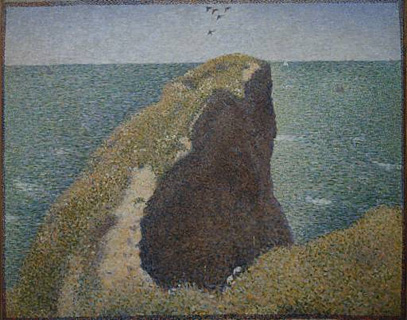Today is the sixtieth anniversary of D-Day, so this week’s painting is a depiction of one of the most vigorously contested rocky prominences overlooking the beaches of Normandy: Le Bec du Hoc, Grandcamp, by the French artist Georges Seurat. The work was painted in 1885, long before the violence of the Second World War impinged on this stretch of the French coast and it shows a natural landmark which, today, is almost unrecognisable. In the weeks leading up to 6 June 1944, German cannon emplacements in reinforced concrete bunkers on the Pointe du Hoc came under heavy bombardment from the U.S. Eighth Air Force and British Bomber Command, while on the morning of D-Day itself a massive barrage of 14-inch shells rained down from the American battleship Texas on to the German positions embedded there. Altogether, the area was hit by more than ten kilotons of high explosive, roughly the equivalent of the impact of the atomic bomb dropped on Hiroshima.
Like many French painters of the second half of the nineteenth century, Seurat developed the habit of dividing his year’s activities according to the seasons. He would spend autumn, winter and spring working on larger canvases such as his celebrated, monumental depiction of suburbanites at play, Bathers at Asnieres (which, like the picture reproduced on this page, can be seen at the National Gallery); while during the hotter months of the year he would travel into the countryside, sketching directly from the motif and painting landscapes. The first of these summer expeditions took place in 1885, when he travelled to Grandcamp, a small town in western Normandy about twenty kilometres to the north-west of Bayeux.
In his Grandcamp landscapes Seurat pushed the new technique which he had been developing, known as “pointillism”, to its furthest extreme. He...


